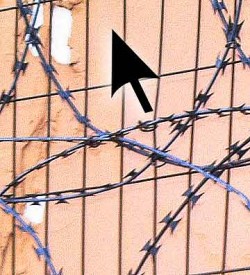Seeking answers, or shared experiences: On a first class cross-country flight last weekend, the trackpad of Bob’s MacBook Air refused to work. His cursor moved erratically or not at all, or opened contextual menus unasked. He turned off his wifi antenna and made sure bluetooth was off. He restarted. He checked his trackpad prefs. No help.
What worked was raising the laptop 24 or so inches into the air. There, the trackpad worked normally. It also functioned well about a foot below laplevel. Meanwhile, the trackpad on my four-year-old PowerBook was fine in any position, including in Bob’s dead zone.
We were on a Boing 737, row 4, Bob in the aisle seat, if that matters. There was a/c power in the seats, and we were plugged in. We’ve used laptops on airplanes for decades, with and without power, in all cabin classes. This MacBook Air has worked flawlessly on about 30 previous flights.
On the return trip two days later, we had aisle and window seats in row 1 on another B737. Same issue. Bob’s troublesome area ranged from laplevel to tray-table height, with a bad buffer of a foot or so above and below. Again, he was on the aisle.
The Air’s cursor moved normally while on my lap in the window seat, and my machine worked fine in all of Bob’s territory. We did not get up and change seats in order to complete experimentation—perhaps the cause was a combination of Bob’s body on the aisle.






2 Comments
Oh! Thank you for explaining the cursor dead zone! We’ve experienced this several times, but always on a B737.
It certainly sounds as if there was a high level of electromagnetic interference at that point. EMI strong enough to stop electronics working is not too uncommon — ask the AAA man about vehicles with central locking which are parked too close underneath a TV transmitter mast.
What is slightly unusual in this case is that it was so localised. That suggests the EM energy is in a stable standing wave pattern — probably because the inside of an aircraft is approximately a hollow conductive cylinder, which forms a waveguide at appropriate frequencies.
The avionics EMI guys — the ones who say you can’t switch on cellphones at take-off and landing — specifically test for this sort of thing and try to avoid it, but it is very hard to be sure because all the gelatinous semiconductors (a.k.a. passengers) change the field patterns in complicated ways.